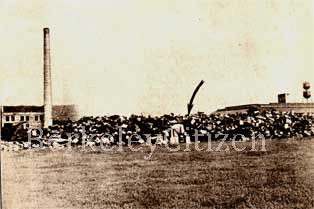
City of Berkeley Municipal Incinerator
|
 |
|
It has been necessary to reject the refuse from certain collectors to secure even a measurable compliance with the With the aid of this separation, however, we have been able to operate for the past six months without the use of any fuel, and have had no difficulty in maintaining temperatures of from twelve hundred to two thousand degrees. These temperatures enable use to eliminate all odor and practically all smoke.
The collection of refuse remains one of the pressing problems for solution. As a corrective for the man inequalities in charges which existed throughout the city, a rate schedule was fixed which should govern the maximum rates that might be charged. We have attempted to substitute for the several independent competing firms now collecting in Berkeley, a single collector, who should have an exclusive privilege for the periods of the contract and who should furnish a bond for the performance of the work in compliance with the ordinances governing the same. The single hid received on this proposition was rejected as too low. This department has, gone into the matter carefully, and is certain the exclusive privilege should yield practically enough to pay for the operation of the incinerator and leave a fair margin of profit to the contractor.
With this idea in mind, bids have been called for a second time for a period of five years in the hope of making the proposition sufficiently attractive to bidders to enter into competition who would be able to in stall modern motor equipment and carry out the collection more efficiently and economically. Municipal collection alone will satisfactorily solve the problem and the provision for the city taking over the collection at any time has been incorporated in the new proposition.
If the city's revenues were sufficient, with an expenditure of $15,000.00 for equipment and an annual appropriation of $25,000.00 for operation, we could now do what the individual householder, are now paying approximately $45,000 a year for, and do it better. This is another of the difficulties incident to our limited income.
• San Francisco Call, Volume 112, Number 128, 6 October 1912
BERKELEY ANS FIGHT INCINERATOR PLANT
Residents Opposed to Garbage Reduction Project in Western Section
BERKELEY, Oct. 5 Although the city council bad definitely decided on situating the proposed municipal garbage incinerator on city property at Second and Harrison streets, the action may be rescinded because of a long protest filed with the council by residents of West Berkeley.
There are 800 names affixed to the document, and this showing of popular feeling in the western section has already given the city officials pause. T. A. Seagrist appeared before the council with the protest. "The people in the neighborhood where the Incinerator is to be placed do not make the garbage," said Seagrist. "Why should they be compelled to take it? You told us that the incinerator will not be a nuisance. If that be true, it should be put in a central district, to reduce the coat of long hauls."
The council did not pay much attention to Seagrist threat that the West Berkeleyans would take legal action to keep the incinerator out of their neighborhood, but listened to a statement by A. Turner of the Pacific Disposal Company. Turner held that a garbage district should be formed with Oakland and Alameda, service to which, he said, could be supplied by a corporation at an economical rate. Mayor Wilson, who remarked that 800 signatures to the protest indicate a solid sentiment in West Berkeley, promised to interview Mayor Mott of Oakland.
The council had already adopted preliminary plans for the incinerator as prepared by City Engineer J. J. Jessup and set a date next month to receive bids. The site chosen, at Second and Harrison Street, was bought for a garbage crematory by a prior administration.
Berkeley Citizen © 2003
All Rights Reserved
All Rights Reserved